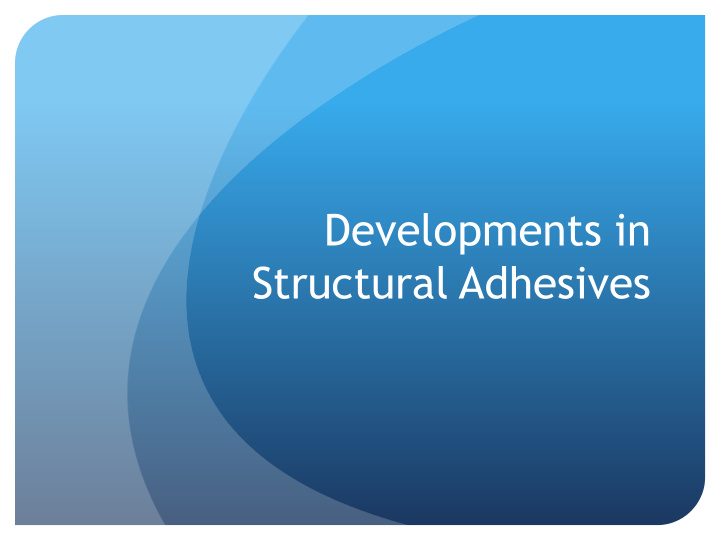



Developments in Structural Adhesives
Introduction Characteristics required for a Structural adhesive - Durable for the lifetime of the timber structures (min 50 years) - Adhesive must not creep - Bonding mechanism stronger than the wood - Must comply with AS/NZS4364:2010
Types of exterior Structural Adhesives Phenol Resorcinol Formaldehyde (PRF) Polyurethane (PUR or PU) Aqueous Polymeric Emulsions (API or EPI) Semi-exterior Melamine Urea Formaldehyde (MUF)
Phenolic Resorcinol Formaldehyde Pros Very durable and strong Fairly easy to work with excellent pot life (eg 1 1/2hour pot life in many cases) Can be expensive Can be cured at ambient temperature Very forgiving Excellent track record for performance in the field Good Shelf life 12-18 months (at least) Cons Can be slow to cure without addition of extra heat (approx 4 hours at ambient temperature) Formaldehyde based (carcinogenic) If housekeeping not maintained can be very dirty and messy
Polyurethane Pros Durable and strong Easy to work with and is in a single pot so no mixing Upfront cost of glue can be expensive (however uses ½ spread rate of PRF) Can be cured at ambient temperature by using moisture in the wood Little to no waste of glue or waste water Cure times can be VERY fast Cons Needs very tight manufacturing conditions to ensure good bonding Some PUR ’ s are high foaming which can cause adhesion to press beds Requires separating agents and cleaning agents 6 month shelf life
API/EPI Pros Bonds are semi-structural and strong in interior and semi- exterior situations Cost is reasonable Works of some timber species that other adhesives can not bond Cons Not well accepted Is susceptible to creep Has pot life issues and is a two part mix, which requires automated equipment Shelf life 3 months
Melamine Urea Formaldehyde Pros Durable and strong in semi exterior conditions Fairly easy to work with even though it needs a hardener added thus requires mixing Cost is very reasonable Cons Requires heat to cure Needs an acidic hardener Needs very tight manufacturing conditions to ensure good bonding Can have problems with formaldehyde smells Shelf life 3 months
PVAc (Structural and Exterior?) - NO Pros Durable and strong in interior and sometimes wet situations Can be cured at ambient temperatures Good track record for performance With Aluminium Chloride added can make water resistant Very cheap Cons Does not pass cyclic wet/dry testing Creeps
Where do they sit with the standards testing Shear Test MUF did not survive freeze, dry boil test Delamination Test PRF , PU, MUF and EPI all passed Creep Test EPI failed
Recommend
More recommend